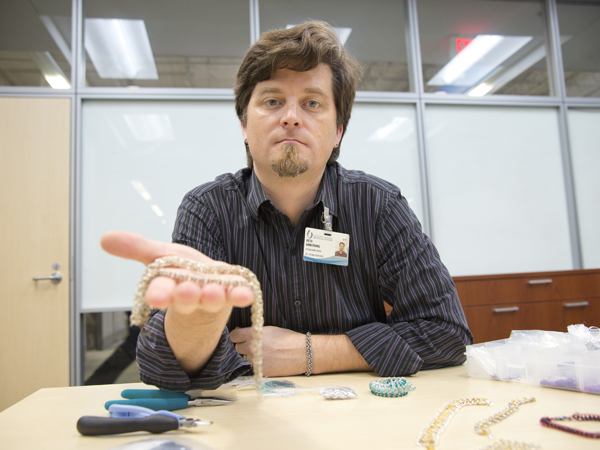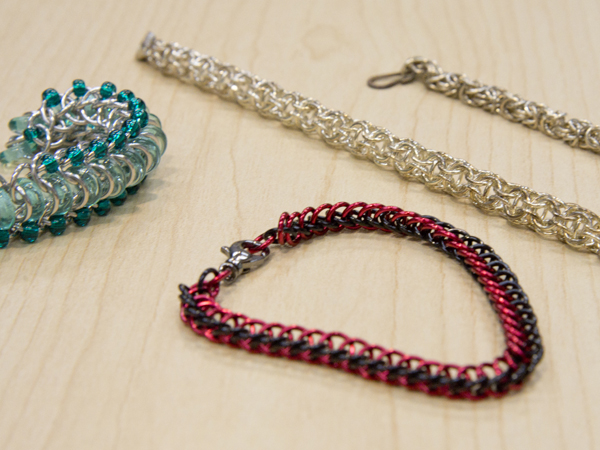People of the U: Keith Armstrong

Published in News Stories on September 14, 2015
What do chainmaille jewelry and the armor medieval knights wore to protect themselves in battle have in common?
Everything, says a University of Mississippi Medical Center senior systems administrator.
Keith Armstrong crafts beautiful necklaces, earrings and bracelets from metal rings of many sizes, using the very process employed to create heavy chainmaille shirts, leggings and coifs during the Middle Ages for military knights who could afford it.
"It's actually all the same thing," Armstrong said. "Jewelry came about from the leftover rings from the making of chainmaille armor. They'd put the rings together in different configurations to make jewelry out of it. It's one of the oldest forms of jewelry-making."
Armstrong has tried his hand at many crafts, including decorative knots and leather work. Making chainmaille is a great creative outlet, he said.
"I call myself a jeweler, and my specialty is chainmaille," he said. "I had a friend in college 20-something years ago that actually did chainmaille armor as a hobby. I got bored one night and started making the jewelry as gifts and to keep myself occupied. Then I started giving away pieces, and then people started offering to pay for it."
Armstrong uses pliers to fashion rings made of soft metals, including silver, gold, stainless steel and aluminum. "I use a lot of surgical steel. It's hypoallergenic and strong," he said.
The ring sizes vary, with the most common size being about 16 millimeters. "There's no limit on a size, other than it being practical," Armstrong said. "The size of the rings depends on how complicated the pattern is. The thickness of the rings also plays into it."
There are dozens of patterns that chainmaille jewelers can use in making jewelry, but the most common one - the four in one - was also the most common pattern used to make actual armor.
"It's four rings linked into a ring, with four connections per ring," Armstrong explained. "You start with one ring, and you connect four rings to it. Everyone starts with that, because it's the most simple. You use different patterns, because it gets boring to do the same thing over and over."

Tiny metal links are intertwined to create chainmaille jewelry.
How long it takes to finish a necklace or bracelet depends on the complexity of the ring pattern he chooses. Armstrong can polish off a four-in-one piece in 30 minutes while sitting in front of the television. "For a complicated piece, it can take days or weeks, depending on how small the rings are.
"The smaller the rings are, the more detailed the piece has to be. You have so much space to take up. You end up having to get magnifying glasses," Armstrong said. "Now that I've gotten older, that's really harder to do."
He often adds beads to the mix to create a different look. "It all depends on the materials you use," Armstrong said of what color a particular piece might be. "Things like copper wire come with a plastic coating. Harder metals, like stainless steel and aluminum, go through an anodizing process. You can get a rainbow of colors, like blue or purple."
The jewelry is quite durable and moderately priced. "For the most basic of items, like an aluminum bracelet, it would be between $25 and $30," Armstrong said. "The steel bracelets I would do would be a minimum of $40. But I've made sterling silver jewelry in the $500 range. The cost is based not just on how long it takes to make, but the materials."
One of his most treasured pieces, Armstrong said, is a bracelet he made as a birthday present for his wife, glass artist and Mississippi Craft Show owner Miranda Jordan. He used anodized niobium, a metal that shines with a pearlescent blue color.
Although some might consider the creation of chainmaille jewelry monotonous, Armstrong does not. "I have not gotten tired of it yet. It's very therapeutic, at least for me," he said.
"You're doing the same thing over and over. You don't have to pay attention to what you are doing, other than keeping the same pattern going.
"It's knitting with wire."
Visit Armstrong's Facebook page at https://www.facebook.com/KissMyArtsMS?fref=ts
Nominate someone for a Front and Center feature
Do you know a UMMC faculty or staff member, student or volunteer who you think should be profiled in eCV?
The editors of the Medical Center's electronic newsletter are seeking nominations for its ongoing "Front and Center" human-interest feature.
We recognize that all of our employees are dedicated to providing their best service to the institution. The POTU articles focus on individuals who have a story to tell that would be of special interest to the newsletter's general on- and off-campus readership. And the story doesn't even have to involve health care.
Know someone who has a special hobby? Who has an interesting past? Who has demonstrated a particular talent? Who has caught your attention and you're dying to learn more? We'd like to hear about it.
If you'd like to nominate someone, click here (UMMC log-in credentials required).


